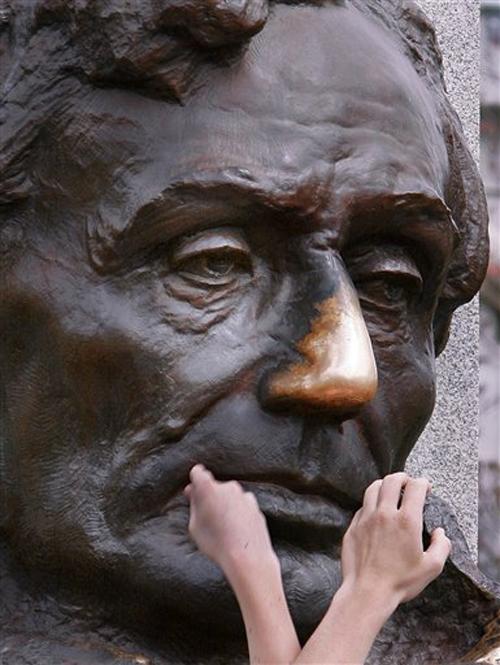Stealing Lincoln’s Body
Apr 23, 2007
Last updated on May 12, 2016 at 11:20 a.m.
CHICAGO (AP) – When it comes to Abraham Lincoln, apparently there’s no such thing as enough.
After countless books about his boyhood, his presidency, the hunt for his killer and yes, even his feet, maybe it was time for a new book devoted to what happened to Lincoln’s body after he was done using it.
As its title implies, “Stealing Lincoln’s Body,” by Thomas J. Craughwell (The Belknap Press of Harvard University Press) is devoted to Lincoln after, as Craughwell writes in the first sentence, “the last tremor of life” left his body.
Craughwell details a little-known plot to steal the 16th president’s remains from his tomb in Springfield, Ill., in 1876 _ 11 years after he was assassinated by John Wilkes Booth.
Get The Daily Illini in your inbox!
The plan, hatched in a Chicago tavern, was to take the coffin from the tomb, put it in a wagon, haul it 200 miles north to the Indiana Dunes and hold it until the state of Illinois paid $200,000 ransom to get it back.
The plot was doomed from the start, though, in large part because the criminals weren’t very bright.
“They really were knuckleheads,” said Craughwell, a Chicago native who now lives in Connecticut.
The ringleader was James “Big Jim” Kennally, a convicted counterfeiter and co-owner of a Chicago tavern called The Hub. The Secret Service, established precisely because counterfeiting was a huge problem at the time, knew that The Hub was a favorite watering hole for counterfeiters.
Enter Lewis Swegles, a small-time crook _ and not such a good one at that _ who by this time was working as a Secret Service informant.
Kennally and his cohorts asked Swegles if he wanted in on the heist of Lincoln’s body, to which Swegles reportedly replied: “I’m the boss body snatcher of Chicago.”
Today, a line like that might raise questions. At the time, though, there were plenty of medical schools eager to get their hands on cadavers. And they didn’t ask a lot of questions about where their suppliers got them.
So Swegles had himself a job. He tipped off the feds and the two groups _ crooks and cops _ boarded the same train bound for Springfield on Nov. 6, 1876. Kennally didn’t make the trip.
At the cemetery, the Secret Service agents and a couple of Pinkerton detectives they’d brought along hid and waited for Swegles to give them the word that the crime was in progress.
Meanwhile, the grave robbers and Swegles walked to the tomb.
“There was no night watchman … and the custodian of the tomb lived in Springfield, two, three miles away,” said Craughwell. “The only security, if you call it that, was a single padlock.”
As for Lincoln’s body, it was above ground, inside a sarcophagus sealed, not with cement, but plaster of Paris. When the robbers broke into the tomb and opened the sarcophagus, Swegles signaled the agents to move in.
If the crooks were a hapless Gang That Couldn’t Shoot Straight, it was about to become clear they were up against the Keystone Kops.
Either before he started running across the lawn to capture the crooks or as they were running, a nervous Pinkerton detective cocked his pistol.
“It went off,” said Craughwell. “In a quiet cemetery in the middle of the night it sounded like a cannon shot.”
The robbers dropped their crowbars and saws and ran away. Not knowing the crooks were long gone, the lawmen searched the darkened cemetery. Before long, they were shooting at each other. Perhaps not surprisingly, their aim was as bad as their judgment and nobody was hit.
Meanwhile, the crooks scurried to the one place they should have avoided: The Hub. That’s where they were picked up a couple days later.
None of this made much of a splash, Craughwell explains, because it took place on the night voters cast their ballots in the presidential race between Rutherford Hayes and Samuel Tilden _ a hotly contested race that wasn’t decided until the next year.
“In some cities the Lincoln break in didn’t get any coverage,” said Craughwell. “And in some cases (newspapers) printed the story but they told their readers it wasn’t true.”
The attempt to steal Lincoln’s body has been covered before. The first time was in 1890, when the custodian of the tomb wrote his own book, and most recently in 1990, with Bonnie Stahlman Speer’s book, “The Great Abraham Lincoln Hijack.”
But Craughwell’s book shows there still is a hunger for anything to do with Lincoln. And just two years before the 200th anniversary of his birth, interest seems to be intensifying.
Craughwell acknowledges that if it weren’t for Lincoln, a book about a bungled grave robbery wouldn’t be quite so interesting _ for the simple reason that Lincoln has a hold on people like nobody else in American history.
“People admire Washington but they love Lincoln,” he said.
Bob Bender, senior editor at Simon & Schuster, which has published several books about Lincoln, agrees.
“He has been a best-selling subject since probably the month after he died …. (and) it’s picking up. You are going to see all of the Lincoln books come back on the market in the next two years.”
In fact, there’s an old adage in publishing that the way to ensure a book is a best seller is to write about Lincoln, dogs or doctors _ which prompted one author to title a book about publishing in the 1930s, “Lincoln’s Doctor’s Dog.”
“The only requirement,” Bender said, “is you have to have something fresh to say.”






